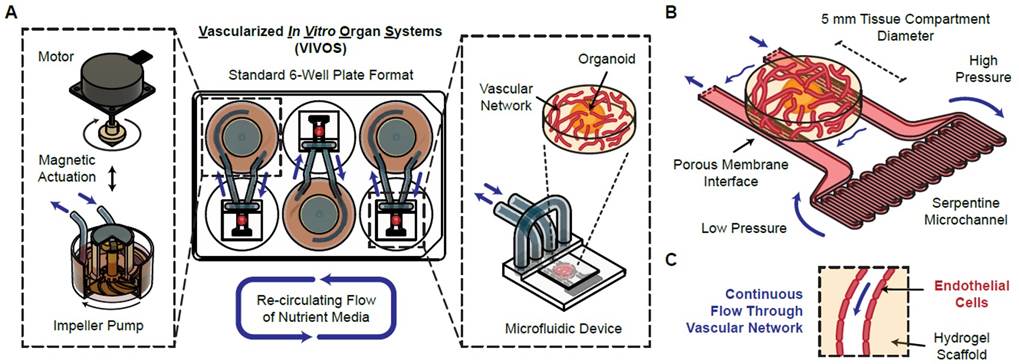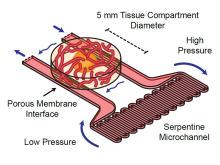BACKGROUND
Vascularized organoids are crucial for accurately modeling human tissues and organs because they mimic the natural blood supply, ensuring proper oxygen and nutrient distribution, waste removal, and cellular signaling. Current organoid systems, however, face significant limitations, such as inadequate vascular networks, which lead to hypoxia, nutrient deprivation, and cell death in the organoid's core. These deficiencies hinder the organoids' ability to fully replicate the complexity and functionality of native tissues, limiting their utility in disease modeling, drug testing, and regenerative medicine. Addressing these challenges is essential for advancing organoid technology and its applications in biomedical research.
TECHNOLOGY
Our researchers have developed a novel pump-based system for culturing perfusable blood vessels and vascularizing organoids called VIVOS (Vascularized In Vitro Organ Systems). The system consists of an impeller pump connected to a microfluidic device housing a tissue compartment (Figure 1). The pump pushes media from a reservoir into the microfluidic device. A pressure differential between the spanning channel arms of the microfluidic device (caused by a serpentine channel) allows the transverse passage of media through the tissue compartment. In the presence of endothelial cells in a hydrogel, this results in vascularization in the tissue compartment; in the additional presence of an organoid, this results in a vascularized organoid. The pump and microfluidic device use minimal tubing and three independent units can be accommodated in a 6-well plate, with up to 48 units in a standard incubator.

Figure 1. VIVOS device for vascularization of organoids. (A) The device is composed of a magnetically actuated impeller pump and a microfluidic channel containing a tissue compartment that sits on top of and spans the two arms of the channel. (B) The presence of a serpentine microchannel creates a pressure differential in the arms of the channel allowing for the transverse flow of media through the tissue compartment, (C) enabling the formation of a vascular network in the absence or presence or organoids.
COMPETITIVE ADVANTAGE
- Capable of producing perfusable blood vessels or vascularized organoids
- Continuous tunable physiological vascular flow
- Large ~1mm x 5mm x 5mm sized compartment compatible with most organoid types and sizes
- Includes developed assays for measuring vascular flow velocities, vascular permeabilities, and vascular morphology
- Optimized modular impeller pump system and microfluidic chip design for high reproducibility, robustness, and user friendliness
- 48 independent units per incubator with minimal tubing
APPLICATIONS
- Drug discovery and development
- Research
INTELLECTUAL PROPERTY STATUS
- PCT application filed (Sept 2024)
PROJECT STATUS
A prototype of the device has been built and tested. Endothelial vessels grown in hydrogel displayed key features such as depositions of basement membrane proteins and a presence of a lumen. Growth of a vascularized human cerebral organoid was successfully demonstrated.





